Efficient Roadways: How the Masspike is speeding up your commute
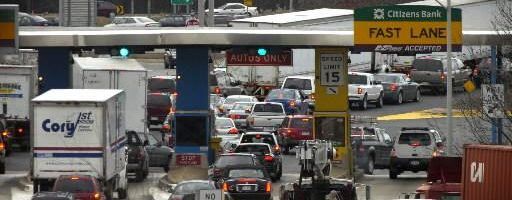
Since the construction of the first Turnpike, the United States highway system has evolved due to the needs of the people and military, with many of these improvements supported by taxes rather than tolls. Due to the aging highway system and states lacking the funds to maintain the roads, the toll concept began to re-emerge. This concept is not foreign to the state of Massachusetts, but how should tolls be implemented without comprising roadway efficiency?
The Massachusetts Turnpike (Mass Pike), in Figure 1 below, also known as I-90, has been collecting tolls since it first opened in 1957 on the premise of maintaining high quality roads. (1)
Figure 1: Massachusetts Turnpike (2)
Highway tolls have historically been a manual process, requiring drivers to come to a complete stop and pay operators during all hours of the day. In 1998, the Massachusetts Department of Transportation (MassDOT) installed an electronic tolling system known as Fast Lane, which later merged with E-Z Pass. According to MassDOT, as of March 11, 2015, the Mass Pike consisted of 24 plazas with a total of 147 toll lanes, 77 of those lanes were staffed, and the other 70 were E-Z Pass. The manual process was much more labor intensive not only at the toll booth but also for cash collection and included additional processing steps such as armored car service, counting rooms, auditing, cash control systems, and security. The staffing needs for the manual process required 491 employees, whereas the electronic process required only 135 employees. (3) Due to the additional process steps and labor requirements for cash collection of the manually operated tolls, the operating costs differed drastically, especially when compared to total revenue collected, and this is shown in Figure 2 below. (4)
Figure 2: Manual and Electronic Collection Operating Cost Comparison (4)
From the drivers perspective, the E-Z Pass system drastically reduced wait times at the tolls, however there is a caveat and that is, the E-Z Pass only reduced wait times during low-medium volume traffic time frames. Unfortunately, most commuters use the Mass Pike to travel to and from work between the hours of 0600-0900 and 1500-1900 and will typically find themselves in traffic due to the manual toll process and are unable to use the ‘E-Z Pass Only’ lanes as seen below in Figure 3.
Figure 3: Mass Pike Traffic Jam (5)
Although the E-Z Pass system was originally a step in the right direction to relieve traffic at the tolls, MassDOT needed to make improvements to the system to account for the high volume timeframes.
Automated Electronic Tolling (AET)
As of October 28, 2016, Massachusetts rolled out its new AET system. AET, unlike the E-Z pass system, is a fully automated tolling system that eliminates the need for collection stations. AET is compatible with the current E-Z pass transponder for charging drivers and will also use license plate imaging to identify and bill (via mail) drivers without transponders. Figure 4 below shows a typical AET toll zone, in which a total of 16 AET gantries will replace the 24 existing toll plazas. (4)
Figure 4: Typical AET Toll Zone (3)
Installing and integrating the AET system, in the end, will cost roughly $474M, which includes construction of the gantries, “backoffice” and customer service centers, and demolition of the existing tolls. (4) Although there is a high upfront cost to the AET there are many financial and non-financial benefits that will be shared by both the state and drivers.
Financially, the operating cost of the tolling system will decrease by an estimated $23M in its first year of operation. This savings is due mostly to the elimination of the manual collection process and the reduction in labor that is required to operate the AET system. (4) While the state is saving money, drivers also receive benefits which include a price reduction (7%), decreased time in the car, reduced fuel costs from idling in traffic, and safer commutes. It is expected that each year with AET that drivers will save over 280,00 hours of vehicle delays annually and 500 to 2500 gallons of gasoline per day. (4) With idling times reduced, this saves 1800 to 7800 tons of CO2 from being emitted into the atmosphere per year. (U.S. Energy Information Administration, 2016) In addition to the environmental and economic benefits, AET systems on average improve safety on the highways by eliminating up to 28% of the total number of accidents. (7)
What’s Next?
As technology continues to be developed and implemented for highways, its important to understand how all roadways are interconnected, not just improving one part of the system. The implementation of the AET system is the first step in optimizing our daily commutes. This technology collects real-time data that can be used by transportation engineers to reduce congestion and maximize flows. (8) Eventually as more roadway systems are installed and integrated, the data that is collected can be used to begin optimizing the supply and demand of road space, reducing costs and travel time, essentially making our methods of travel more cost effective and efficient.
(769 Words)
1) Cambridge Systematics, Inc. (2010). Massachusetts Turnpike: Metropolitan Highway System Traffic and Revenue Study.
2) Geology.com. (2016). Map of Massachussetts Cities and Roads. Retrieved November 2016, from http://geology.com/cities-map/massachusetts.shtml
3) Collins, S. M. (2015, March 11). All Electronic Tolling. MassDOT.
4) Tinlin, T. J. (2015, November 18). All-Electronic Tolling Update.
5) Getty Images. (2016). Aerial Traffic Backed up at multi-lane Massachussetts Turnpike toll booth. Retrieved from http://www.gettyimages.com/detail/video/traffic-backed-up-at-multi-lane-massachusetts-stock-video-footage/mr_00091414
6) U.S. Energy Information Administration. (2016, April 26). Frequently Asked Questions. Retrieved November 16, 2016, from http://www.eia.gov/tools/faqs/faq.cfm?id=307&t=11
7) Abuzwidah, M., & Abdel-Aty, M. (2014). Safety Assessment of the conversion of toll plazas to all-electronic toll collection system. University of Central Florida.
8) Q-Free. (2011). Electronic Toll Collection Technologies for Road Pricing.


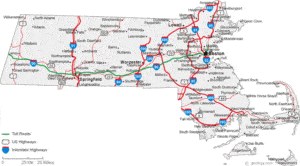
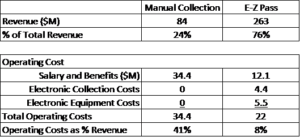

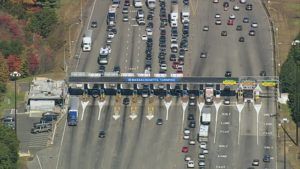
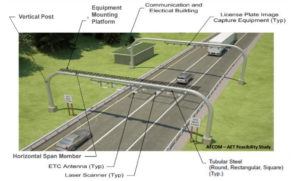
Thanks for the insightful read! With operating expenses at 8% of revenues for EZPass vs. 41% of revenues for manual collection, the business case for migrating to completely automated tolls is certainly clear. I was surprised that the payback period for this project is so long. With $474 in implementation costs and an annual savings in operating costs of only $23M, the payback period (ignoring time value of money) is nearly 21 years. However, that doesn’t take into account the substantial social/economic/environmental benefits you mentioned, which should clearly factor into the calculation. Finally, do you know what happened to the manual toll collection workforce? Were they laid off or were they able to be placed in other state positions?
Highly relevant post given the timing of the construction near campus last month.
Agreed with BJF above that the economic benefits are clear, and that the spillover social/economic/environmental benefits are tremendous. I particularly liked your last point — the real value of moving to the automated toll is in the real-time data collection used to optimize traffic patterns. This investment can generate value for many future projects in the state, in which case all future benefits can be tied to this fixed cost implementation in part or in whole. Now that MassDOT has this data available, data scientists can analyze patterns and drive change (pun intended) through learnings. This positive feedback loop should incentivize other state DOT’s to invest similarly given the cascading benefits. Coming from California, where there are no tolls, I can still see the value in having real-time data generated from these automated booths.
Thanks for the great read! As with the first commenter, I’m surprised that the payback period is so long for something like this – would have thought that the savings would be significant relative to the cost. Maybe there’s something to be said that 75% of revenues are already coming through EZ Pass, which is very close to the AET model, so a lot of the efficiency has already been realized?
Norway is probably a very good proxy for what a fully developed AET-like system looks like. In Norway, all cars are fitted with toll chips that automatically collect payment once the car passes a toll sensor on the road. The process is very efficient and reduces waiting time / traffic time. License plate recognition is likely the best option for mass implementation here in the US given the difficulty of installing chips into so many more vehicles, but I imagine the optical technology required to scan license plates and the manual labor that may be involved in reviewing footage make it more expensive than the chip-sensor model in Norway.